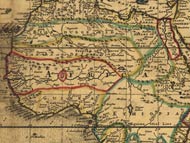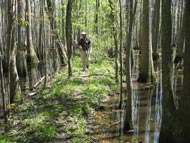Studying Inland Rice Fields
Most 19th and 20th -century narratives about rice cultivation and production focus on tidal rice technology. However, it was inland rice not tidal rice production that necessitated the importation of 70,000 enslaved Africans to Charleston in the 18th century and fueled the economy that made Charleston the jewel of British North America.
Unfortunately, little work has been done to document these inland rice fields, to explore how rice was grown in the Lowcountry between 1690 and 1780, and to understand the technical role enslaved Africans played in the early development of the industry. Research tells us planters preferred to purchase captives from the rice growing lands of West Africa. Although Europeans were familiar with methods for controlling and moving water, they had no experience growing rice.
As residential and commercial development spreads throughout the Lowcountry, more opportunities arise for remnants of these early rice fields to be observed and studied by historians and archaeologists. In 2010, Charleston County sponsored a study of inland rice fields located within the greater Charleston area. Archaeologists and historians visited numerous early inland rice fields to gather information about the construction and organization of these rice systems. The results of their work are presented here.



